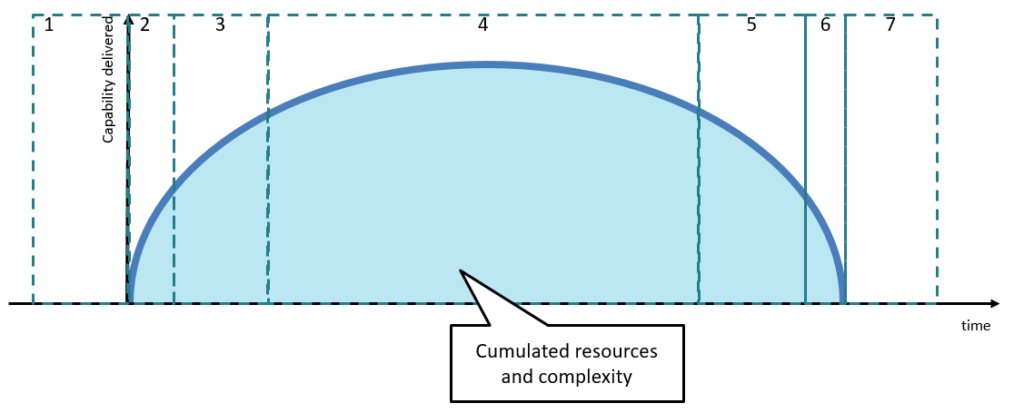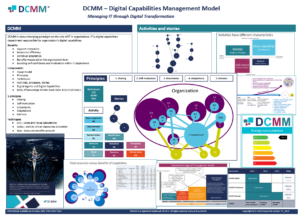 DCMM : Digital Capabilities Management Model
DCMM : Digital Capabilities Management Model
Download DCMM Insight in PDF
Why DCMM
Since the early 1990s internal IT departments have been adopting new technologies to digitize existing business processes. IT management started to evolve using a process focus, where consistency and efficiency meant fast incident resolution. Later, IT moved on and elevated its capabilities to provide business services, the focus was shifted towards the delivery of IT defined services that meet “customer” (understand business) requirements. In the last 20years agile has disrupted traditional IT management with a prioritization of speed, responsiveness and time to market. In the early 2000’s e-banking and e-commerce held a competitive advantage; speed and continual delivery of software developments was the competitive advantage moving quickly to meet changing needs. There has been no significant modernization of IT management in the 20 years that have passed since this new paradigm was created, but the change in our world has accelerated – AI, complex self-managed systems, exponentially complex security, the need for exploration and innovation became the driver of digital transformation. Yet IT management has remained stuck in the past, acting as a separate organisation, expecting that the rest of the business will bring their requirements. As we enter 2021, IT management must radically change once again to meet the new reality we all now face.
Today problems:
- IT is approaching the business as a customer, adopting a passive role.
- Finding innovative idea’s is enormously complex, high risk and resource demanding, yet IT does not. see their role in delivering its benefits to the organisation.
- IT management overhead is largely ignored, IT is self-centric, they do not consider the business context of their activities focusing on tasks which are unimportant to the business creating a perception of high cost, little return.
- Service logic became has obscured the more strategic role of IT departments.
- Digital transformation requires redefinition, the questions of; What is IT, what is IT’s role in digital transformation have, until now, been left unanswered.
Adopting the DCMM model means the following.
- IT will act as a neural system within the organisation.
- IT is positioned as an enhanced digital capability function.
- IT will become a source of continual innovation.
- IT focus, will be on knowledge work to support organizational growth.
- Management complexity is greatly reduced, freeing up resource and increasing business agility tenfold.
- Digital agents (algorithms, digital employees) are recognised as a critical asset, managed by IT.
The evolution of IT management is described in the next picture, and DCMM is the next stage in that evolution, where IT is an active participant in successful business transformation.

Problem of thinking “external” – logig of ITSM and Agile
Both model are coming from communities defining customer as someone external, using logic of “us and them”.

This thinking creates a certain management pattern where main motivation is to satisfy customer to enable economic transactions – billing. As the economic transaction is the driving force in the relationship, necessary management practices must be put in place, like request/change tracking, SLA, reporting, service catalogue and customer acceptance etc. Both models accumulated large experience from the context of where they came from, created entire ecosystems of consultants, trainings and tools support.
But critically important question is being asked by many CIOs who are working inside organizations.
CIO: How do we know, that acting as a service provider is the best possible management model?
This simple question was the starting point of exploration and then design of an entirely new management model DCMM, which is structured around completely different thinking.
Sources of inspiration
Since about 2010 we can observe rapid emergence of new ideas, challenging widely accepted truths and proposing new solutions to problems arising in the digital era. The new paradigm of economy (CORE model), discoveries in biology (collaboration as the main force in evolution), artificial intelligence emulating brain or complex self-organised organisms are just examples of what we see everywhere. Old truths and models are proving to be unfit for purpose in today’s complex reality.
DCMM fundamentals
Digital Capabilities Management Model is describing a new paradigm on the role of IT. Rather than acting as someone external, IT as integral, inseparable part of its organization, as an organ in an organism. Over the whole DCMM book we use many analogies with nature and living organisms, which is also providing great aid to explain rationality behind this suggested management model.

Fundamental difference to previous models is perception of IT as a part of its own organization. This means that many practices motivated by economic transactions could be either eliminated or minimized to preserve administrative overhead. As simple as the fact that organizations exists to create shorter communication links and eliminate administration costs of external relationships. Surprisingly authors of previous models didn’t ask themselves, why organizations exist and suggested their models for internal IT also.
DCMM model parts
Key building block of DCMM are collaboration, innovation and continual adaptation with minimized administrative overhead.
While creating DCMM model, we focused on practicality and creation of new and different management patterns, which are supporting CIOs in digital transformation. While many authors provide well intended advices that IT should transform, they are very unclear in describing to WHAT. DCMM is thus a practical guide to WHAT and provide documented IT management model for the modern CIO.
Components of DCMM are:
1. Visual proportional model
2. Principles
3. Activities, stories, processes
4. Digital Agents and capabilities
5. Techniques
1. Visual proportional model
This next picture is providing a visual DCMM model and within it also visual model of IT (right part of picture). Unique and innovative idea behind DCMM is using proportional sizes of graphics to visualize resource consumption and capabilities provided. Using proportions in a visual model offers a great communication help you show what IT does and to what the resources are transformed into.

2. Principles
Working inside brings massive consequence, as we approach and treat our colleagues in different manner than someone external.
• Sharing – IT is sharing organizational resources with other departments
• Self-motivation – IT is acting without explicit request to act, becoming proactive
• Uncertainty – due to complexities and ever ongoing changes the outcomes of acting is frequently unpredictable, and this must be supported in your management model
• Adaptation – every part of your organization including IT is learning and adapting
• Fairness – collaboration inside organization is driven by fair resources allocation
Listed principles are driving different behaviours and activities in IT compared to “external” logic, and this means a massive difference compared to ITSM logic.
3. Activities, stories, processes
Most of what IT does is a result of self-motivated actions, frequently driven by activity or availability of resources to start certain activities at a certain moment in time, or responding to unexpected situations like emergency or changed conditions (competition, regulation, malfunctioning).
• New component
• Improvement
• Normal status
• Check
• Modification
• Extension
• Recovery
• Emergency
• Wrong doing
Every activity has a different impact on organizational resources and capabilities. Need of understanding complete resources is one of the significant features of DCMM.
Chains of activities create stories, where continuation of a story is frequently unknown and the decision of what the following activity is only happens based on the outcomes of previous activity.
From the process perspective, DCMM is retaining only few repetitive processes like outage management, provisioning and monitoring in order to be as reliable and flexible as possible.
4. Digital agents
In DCMM IT is responsible for Digital agents. DA consist of processing capacity (aka brain), connectivity (nerves), memory, algorithm, information. Unlike a service, we approach digital agent in a similar way to how we approach humans or living organisms – aging, growing complexity, wrong doings. Working with the digital agent logic means accepting as fact, that some systems could be extremely complex and internal processing logic might even be changing and not fully understandable. Some digital agents might be enormously complex, that the processing logic can’t be verified for correctness – we call this Digital Intelligent Agent aka Digital intelligence.
Understanding aging and growing complexity means also acceptance that we must adopt suitable management techniques for digital agents over their changing age.

Every digital agent is enabling your organization with specific digital capability. In other words, it is not IT who is providing services, instead IT is designing, acquiring and improving digital agents, which then provide organization new or better digital capabilities and gaining the advantage.
5. Techniques
DCMM is oriented practically so we wanted to provide IT professionals with guidance of how to quantify benefits delivered to their organization, Afterall the board will want measure your success.
· CVC – Costs value calculation is traditional model of calculating value delivered through certain digital agents (i.e. less time needed for specific transaction
· ADRA – Activity driven resource allocation – technique describing how to provide iterative resource allocation for new, unproven digital agents to test and verify capability potential
· RBA – Resource / Benefits analysis, key component of DCMM model. RBA describes practical examples how to quantify overall benefits delivered by the whole of IT.
Summary
DCMM is targeted to help CIOs in their digital transformation, to change paradigm on IT in organization as innovative department, capable to deliver large, cross organization projects, bridging departmental borders, able to create digital ecosystems with external partners. Transformation is not a minor iterative step but changing patterns of acting inside IT and also presenting IT as critical capability of every organization.
About the Author
 Zdenek Kvapil is the founder and CEO of Q4IT and the architect of the IT QUALITY INDEX framework and DCMM. He has spent 25 years in the IT industry, from programing through to the management of his own IT consultancy business. His other roles in the industry have included consultant, trainer, speaker and founder of the itSDFI conference www.itsdfi.com.
Zdenek Kvapil is the founder and CEO of Q4IT and the architect of the IT QUALITY INDEX framework and DCMM. He has spent 25 years in the IT industry, from programing through to the management of his own IT consultancy business. His other roles in the industry have included consultant, trainer, speaker and founder of the itSDFI conference www.itsdfi.com.
Contact: @ZdenekKvapil LinkedIn: Zdenek Kvapil
Co-author
 Jonathan Boyd, consultant at Q4IT, has been in IT for over 19 years across many roles and has a wealth of experience gained from many improvement projects across both public and private sectors. He is currently working to support the growth of a number of modern businesses set to positively disrupt their market. He is laser-focused on modernising the thinking behind business enablement from technology and challenging accepted practice.
Jonathan Boyd, consultant at Q4IT, has been in IT for over 19 years across many roles and has a wealth of experience gained from many improvement projects across both public and private sectors. He is currently working to support the growth of a number of modern businesses set to positively disrupt their market. He is laser-focused on modernising the thinking behind business enablement from technology and challenging accepted practice.
Book DCMM available as a paperback or ebook, ISBN: 9781723571923 can be ordered here

Are you interested in? ? Download DCMM Insight document HERE.
DCMM infographics poster
